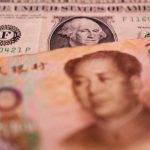SINGAPORE/LONDON (Reuters) -High-level discussions in China about allowing its currency to weaken next year underscore the risk for investors and companies that big foreign exchange moves are coming as U.S. tariffs shift global trade and money flows, analysts said.
Reuters reported on Wednesday that China was considering letting the yuan fall to weather what is likely to be a sharp hike in tariffs, citing people familiar with the matter. The yuan immediately dipped against the dollar, along with currencies across Asia which are highly sensitive to Chinese demand. [FRX/]
While a weaker yuan had been widely expected, with pressure on the exchange rate since the election of Donald Trump as U.S. president, framing it as a policy shift may herald the start of a new round of global tariffs, trade tensions and currency intervention.
“Currency adjustments are on the table as a tool to be used to mitigate the effects of tariffs. I think that is clear,” said Fred Neumann, chief Asia economist at HSBC in Hong Kong.
“Taking the currency weaker might be a signal by China to the rest of the world that there are exchange rate implications of imposing tariffs.”
A cheaper exchange rate helps exporters by making their prices more competitive internationally.
The yuan dipped about 0.3% and as far as 7.2803 to the dollar after the Reuters report. The Australian dollar, which is sensitive to moves in the yuan given its hefty commodity exports, touched a one-year low.
Trump has said he plans to impose a 10% universal tariff on imports to the U.S. and a 60% tariff on Chinese goods.
Financial markets have been bracing for more volatility from his inauguration on Jan. 20, but have been unsure how seriously to take his threats.
Reuters spoke to three people who have knowledge of the discussions about letting the yuan weaken, one of whom said the central bank had considered a fall to about 7.5 to the dollar – roughly a 3.5% depreciation from current levels around 7.25.
Still, that is at the weaker end of investment bank expectations, adding to a sense among investors that China is determined to be better prepared for trade shocks this time around.
“If they need to revitalise the economy, and they tend to be more interested on focusing on exports, there is quite a compelling logic that they may allow the renminbi to soften,” said Jane Foley, head of currency strategy at Rabobank.
INTENSE, FAST
A complicating factor for China is where any slide would leave the yuan relative to non-dollar currencies, especially in Asia where many neighbours such as Vietnam have grown as hubs for finishing Chinese manufactured goods and avoiding U.S. sanctions.
Rong Ren Goh, a portfolio manager in the fixed income team at Eastspring Investments, said he expects China will orchestrate a controlled and gradual depreciation but “Asian currencies, particularly those of export-driven economies, are likely to adjust in tandem with the yuan on a trade-weighted basis.”
China’s exporters have been hoarding dollars with an eye on a rate of 7.5 as a point to start selling, but they have also been seeking ways to avoid taking currency risks altogether by invoicing in yuan and other such workarounds – especially as the yuan has gained this year on peers.
“If China takes the currency aggressively lower, it raises the risk of a tariff cascade,” said HSBC’s Neumann, if it prompts other economies to put up their own levies to protect their industrial base from extremely cheap Chinese imports.
“It could lead to a backlash among other trading partners, and that’s not in the interest of China.”
To be sure, much of the risk lies in the speed or shock value of any U.S. move, and some market participants don’t expect Trump will be in a rush to take direct action.
“There’s some voices in markets calling for a quick 10-20% depreciation (in the yuan) to help offset tariffs,” said ING’s Greater China economist Lynn Song.
“We don’t expect an intentional and sharp depreciation like this as it will be ineffective to counteract tariffs, given this could easily be categorized by the U.S. as currency manipulation and result in further tariff hikes.”
Still, at recent analysts’ briefings in Singapore, Trump’s trade policy was seen as a true wildcard and a weaker Chinese currency was the consensus for analysts at Nomura and MUFG.
“My view is that there will be FX flexibility that comes through,” said Craig Chan, head of global currency strategy at Nomura, before Reuters’ report on China’s forex discussions.
He recommended a few long dollar positions in Asia.
“Long dollar/CNH is one. We have a target of 7.60 by the end of May. It could be intense, could be fast,” he said. “That would clearly be the risk to dollar/China – moving higher, faster.”
And at MUFG, a forecast for a drop to 7.5 per dollar was predicated on the assumption of an average 40% tariff on Chinese goods.

“A 60% tariff on China products would require a 10%-12% yuan depreciation against the dollar (since September) to 7.8 or beyond … everything else being equal,” MUFG analysts said.
During Trump’s first term as president, the yuan weakened more than 12% against the dollar during a series of tit-for-tat tariff announcements between March 2018 and May 2020.
To read the full article, Click Here

